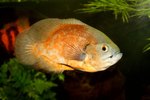
Whiptail catfish have much to recommend them. They play nice with other fish and have an interesting, angular appearance to their bodies. However, they don't seem to show up in aquariums as often as their pleco cousins, possibly because they do not have that same reputation for eating algae. In the right tank, a whiptail can make a nice point of interest.
Tank Setup
Whiptail catfish (Rineloricaria spp.) can be kept singly, in a pair or in groups. A pair can share a 20-gallon aquarium. When keeping more than a pair, add 10 gallons to the minimum aquarium size per additional fish. Whiptails spend a lot of time on the bottom of the aquarium, so use a soft, sandy substrate instead of rocks. Whiptail catfish need lots of hiding places to feel safe, so a tank should have lots of plants and driftwood for the catfish to hide in.
Water Conditions
Whiptails are generally hardy. They require soft water, with 3 to 15 degrees of carbonate hardness. Whiptails prefer acidic pH but can survive in neutral to weakly basic water. Keep them in water with pH between 6.0 and 7.5. They also prefer water on the cool end of tropical, between 72 and 79 degrees Fahrenheit. They share these care requirements with other South American fish.
Feeding
Despite their resemblance to plecos, whiptail catfish are not good algae-eaters. They are omnivores, leaning toward carnivores. Catfish pellets, available at pet shops, feed them well. Often, these pellets are designed to sink to the bottom of a fish tank. You can feed live or frozen fish foods like brine shrimp or bloodworms as an occasional treat. Since they live on the bottom of the aquarium, observe them during feeding time to make sure they get their share of the food if other species share the tank.
Compatibility
Generally, whiptail catfish get along well with any fish that won't bother them. Their mouths are too small to be very predatory. However, any aggressive or nippy fish will find an easy target in a whiptail catfish, so consider tank mates carefully. Also, shoot for fish that enjoy the same kind of aquarium conditions. Fish that prefer a higher temperature or pH belong in a different tank.
References
Photo Credits
-
Jupiterimages/Photos.com/Getty Images




